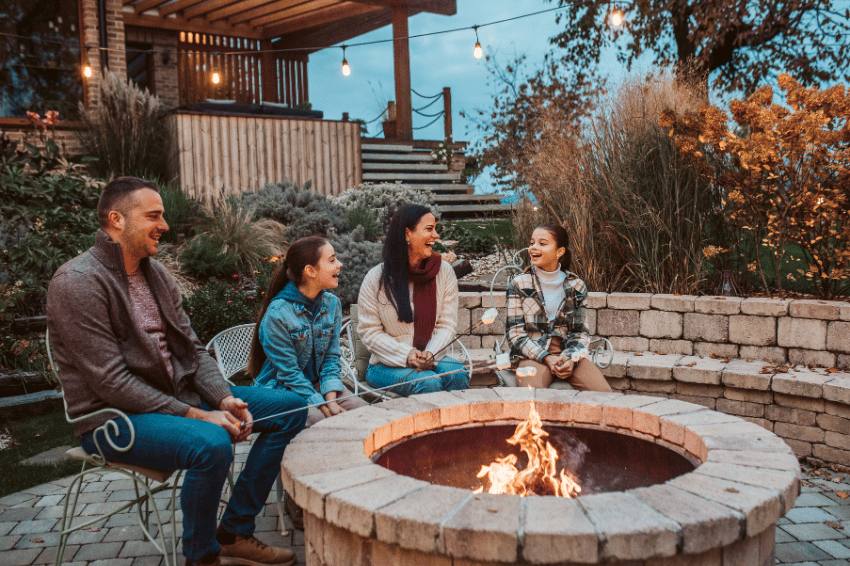A well-placed fire feature can transform an ordinary patio into the heart of an outdoor living space. Flames draw people together, extend the season, and lend a cinematic glow to evening gatherings. Whether your goal is a simple conversation nook or a statement focal point, understanding the fundamentals of fire-feature design will help you create a setting that feels both welcoming and secure. Homeowners in Kildeer, Lake Bluff, and Winnetka often start with the same question: Which type of fire element best matches my patio and lifestyle?
Choose the Format That Fits the Space
Patios vary in shape, size, and traffic flow, so the fire element should echo those proportions. A round stone fire pit provides a campfire feel and encourages guests to gather on all sides. Square or rectangular pits complement modern hardscape lines and allow furniture to stand neatly against straight edges. For smaller terraces or raised decks, a linear gas fireplace set into a low wall adds drama without consuming valuable floor area. Built-in fireplaces can also double as wind screens, a useful benefit along Lake Michigan’s breezy shoreline in Lake Bluff.
Fuel Options and Their Impact
Wood-burning setups deliver the crackle and aroma many people associate with traditional campfires, yet they require space for log storage and regular ash removal.
Natural-gas or propane systems ignite instantly, produce consistent heat, and eliminate smoke, an advantage for compact patios in Kildeer where neighbors may be close. Gas lines must be installed by licensed professionals, but once in place, they provide clean operation and simplified maintenance.
Gel fuel canisters suit small tabletop bowls, offering ambient flicker for intimate seating areas without the heat of a full pit.
Safety and Code Considerations
Local ordinances determine setback distances, fuel restrictions, and spark arrestor requirements. Winnetka’s village codes, for example, outline minimum clearances from structures and overhanging branches. Before breaking ground, confirm these guidelines and secure any needed permits. Position wood-burning units on noncombustible surfaces such as pavers or natural stone, never directly on turf or composite decking. For gas installations, include shut-off valves within easy reach and test connections annually for leaks.
Materials That Endure Midwest Weather
Dense natural stone and concrete withstand freeze-thaw cycles typical along the North Shore. If you prefer metal, choose powder-coated steel or cast aluminum that resists corrosion from lake-effect moisture. Fire-rated glass beads or lava rock fill provide both insulation and decorative flair in gas burners, while ceramic logs offer a traditional look without charring. Whatever material you select, ensure drainage beneath the burner pan so rainwater does not collect and extinguish the flame.
Integrating Seating and Lighting
Plan seating concurrently with the fire feature so circulation feels natural. Built-in seat walls keep cushions safely away from sparks and remove the need for extra furniture. For freestanding pits, arrange weather-resistant chairs at least eighteen inches from the edge to balance warmth and comfort. Low-level lighting, such as recessed tread lights along steps or soft path markers, guides movement after dark without competing with the fire’s glow. Overhead fixtures should be dimmable so guests’ eyes can adjust when flames are the primary light source.
Maintenance for Long-Term Enjoyment
After each burn, allow ashes to cool completely before disposal and sweep debris from burner pans to prevent blockages. Cover units when not in use to protect them from snow and fallen leaves. Gas systems benefit from an annual inspection of burners, igniters, and valves. If your feature includes masonry, inspect joints every few years and repoint mortar that shows cracking. These simple habits preserve both appearance and performance.
Bringing the Vision to Life
A fire feature is most successful when it feels integral to the entire outdoor plan rather than an afterthought. Consider sightlines from interior rooms, prevailing wind direction, and adjacent plantings that may benefit from—or suffer under—radiant heat. When those details align, the result is a space that invites conversation on cool spring evenings and keeps autumn dinners lingering long after sunset.
Curious about incorporating fire into your own patio design? Contact Martin John Landscaping to explore layouts, materials, and fuel options that suit your North Shore home and lifestyle.


